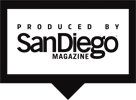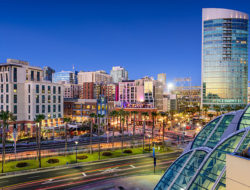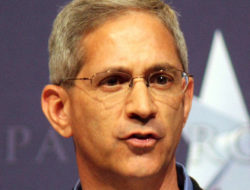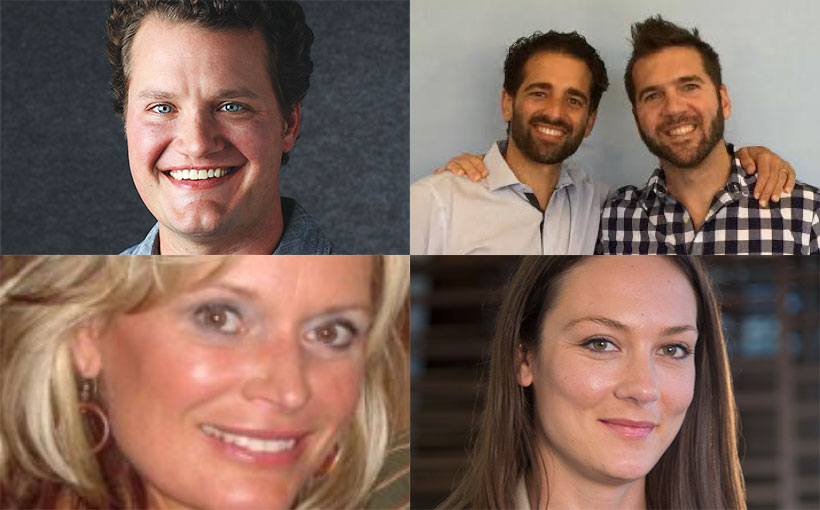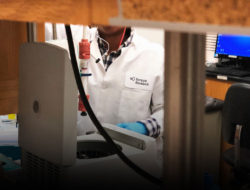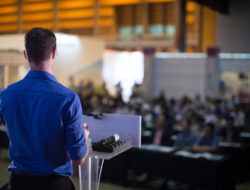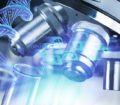As we approached last week’s San Diego Startup Week, we took the opportunity to check in with some founders in the local startup space and assess the state of the San Diego startup ecosystem. We wanted to know what is working and what isn’t. We asked what makes San Diego a great place for startups and what doesn’t. We asked about funding and mentors. The following is what we unearthed and the big takeaways from those conversations.
Who we talked with:
Andy Taylor, Co-Founder of Approved
Approved is developing an online platform for the mortgage industry to enable the electronic submission of documents needed during a mortgage transaction.
Nick Bulcao, Co-Founder and CEO at Airspace Technologies, and Ryan Rusnak, Co-Founder and CTO at Airspace Technologies
Airspace Technologies is disrupting the same-day logistics market by developing a digital platform for customer transparency and increased efficiency.
Ashley Van Zeeland, Co-Founder and former CEO of Cypher Genomics and current CTO at Human Longevity
Cypher is a genome informatics company offering an interpretation software solution for users of human genome sequencing. Human Longevity is a genome-based company looking to transform the practice of medicine through technology and data.
Wendy Rogers, Co-Founder and CEO of eSub
eSub Construction Software is a digital and cloud-based tool for subcontractors in the construction industry to increase communication and coordination on projects so they can perform the work and get paid for the work they do.
Why are you in San Diego?
For Andy Taylor, the decision to launch Approved in San Diego was two-fold. First, Southern California is home to a robust real estate market providing fertile ground for a company looking for a high concentration of mortgage transactions. The second reason is a bit more personal. Taylor grew up in San Diego and after several years at Redfin in the Bay Area, he was ready for a more affordable, family-friendly place to do business.
For Nick Bulcao, founding his company in San Diego was never really a question. He grew up here and never considered launching the business anywhere else. “It was important to me to set up shop here,” he shared. Airspace Technologies is headquartered in Carlsbad.
For Ashley Van Zeeland, the decision was more academic. She came to UCSD from Los Angeles for her post-doctorate and saw how differently the academic world interacted with industry in San Diego compared to Los Angeles. “In LA, industry was a four-letter word. In San Diego, it’s different,” said Van Zeeland. She recalled that there was only one path for a scientist in Los Angeles, but in San Diego she was shown how academic science, public science, and industry could work together to advance things faster.
For Wendy Rogers and her late husband with whom she co-founded eSub, San Diego was a personal choice. “We made a lifestyle choice and moved to America’s Finest City. We made that choice in 1993,” said Rogers.
Many like to compare San Diego as a startup ecosystem to areas such as Austin, the Bay Area, Denver, and Seattle. What is different about San Diego? What makes San Diego authentically unique?
One common theme you will hear in these answers is the lifestyle in San Diego. What we found most interesting is that it doesn’t come from the perspective of people who don’t want to work as hard — they just see through the façade of those who work long hours for no reason, just for show, or because it’s simply expected in that culture. San Diego also has a family-friendly tone to it, and most of these founders mentioned their family and how that plays into their work. Another shared viewpoint is that San Diego is more humble than other ecosystems. It is a place where great work is happening, but we don’t tout it enough.
“People here have a healthy respect for what’s important in life,” said Taylor, a father to young children. He notes that the burnout, grind atmosphere, and high cost of living in the Bay Area wore thin on him before his move back to Southern California. Now in San Diego, he is enjoying the balance as well as the affordability, the fact that he can ride his bike to work downtown from his North Park home, and that he isn’t constantly missing out on time with his family.
Taylor also believes that compared to their counterparts in other cities, San Diego entrepreneurs are humble about their work. He cited San Francisco as a culture that encourages self-promotion among its startups.
Rusnak, who echoed those thoughts about humility and lifestyle, said he was glad there are “fewer burnout shops here.” He talked about the freedom and success that can come from not being driven by venture capital. “Silicon Valley is sometimes disconnected from the world and motivated solely by venture. We are motivated by actual business needs. That’s why we are taking on an antiquated industry.”
“Silicon Valley is sometimes disconnected from the world and motivated solely by venture. We are motivated by actual business needs”
Rogers, who is also knee-deep in an antiquated industry, summed up her thoughts this way: “You have the ability to move fast and forward when you need to, but to stop and take a rest when you can, too. I love the work-life balance, the openness of the community in terms of embracing tech founders and having an entrepreneurial spirit. I know people who came down from the Bay Area and fell in love not only with the lifestyle, but with the people here.”
Van Zeeland was also moved by the people in San Diego. She was encouraged by those around her to go to business school so she could continue her work as an academic scientist with an understanding of how research gets funded. Positioned in the city’s biotech sector, she championed San Diego’s collaborative nature and sense of mission. “We are here to solve big problems in human health and that can take collaboration from all parties,” she said. And when it was time to spin Cypher out of UCSD, she says “the network helped me assemble the company pretty quickly. I had a friend at UCLA spinning a company at the same time and he was having a much rougher time. It took him longer.”
In terms of competition for the biotech cluster, San Francisco and Boston are the only other places with biotech concentrations matching San Diego. Van Zeeland’s take on those two was clear. “I could not imagine doing this in San Francisco. It is dog eat dog, too competitive, and about quick hits. The essence of the mission is missing there. And climate wise, I would never live in Boston.”
Conventional wisdom is that there is very little available capital in San Diego. Most feel you have to go elsewhere to find funding. Is that true for you? Do you think we have enough money available here? Where do you get your funding?
With the recent report from the San Diego Economic Development Corporation that San Diego is getting 22% of the genomics funding nationally, it is clear that funding in that arena isn’t a problem. Van Zeeland, who has benefited from that sector’s funding success, believes San Diego will do better as we continue to do the hard work of creating good companies here. “When you have the right idea and the right team and do the work, you can get the money.”
Those outside the biotech world agreed that there isn’t as much funding available here compared to other cities, but none saw that as a huge hurdle.
Bulcao and Rusnak, who are currently raising money, said there is definitely a lack of venture capital money here beyond seed funding, but they just go elsewhere. “Most of the people we have been talking to are LA or San Francisco VCs. We have talked to one local VC who writes small checks.” They have been focused on partnerships in addition to funding.
Taylor also agreed that seed funding can be found in San Diego, but not a lot of Series A level funding. But he also didn’t seem fazed by that, saying: “Here you can do more with less, and since your capital lasts longer, you have longer to figure it out. It forces you to be scrappy.”
Rogers, who bootstrapped her business at first, agreed the money can’t always be found here and cited our proximity to the Bay Area as a hurdle. “We need more eyeballs on San Diego,” she said. “We are treated as the ugly stepchild of Silicon Valley. California is getting a lot of funding, but we need to direct more here. We need to start separating Northern California money from Southern California so we don’t get overlooked because people think enough money is already coming to California companies.” She also credited the work of Tech Coast Angels and the San Diego Venture Group in terms of raising the profile of San Diego startups. eSub’s funding has come from Revolution Ventures out of Washington, D.C. and San Francisco.
Who do you go to for advice? Who are your mentors here locally in San Diego?
If there was one question that produced the most varied answers, this was it. And other than Van Zeeland, these founders were initially stumped by the question. The takeaway is that each founder and each business needs different advisors and advocates and each have figured out how to get what they need.
Bulcao cultivated a helpful relationship with Sheldon Harris, the former CEO of Coldstone, through ceocoaching.com and now finds his best support through Young Presidents Organization (YPO). Rusnak reported that tech-specific leadership has been hard to find and feels that is also partly due to their North County location which makes networking harder. He did praise the group 7CTOs.
Rogers first praised a non-tech, non-startup mentor, Dough Barnhart, an industry leader in construction and national board member of the Association of General Contractors, whom she has worked with closely. She also credited Ken Bender, founder and managing director at Software Equity Group, and Bill Eigner from Procopio in her success, saying, “It’s taken us 10 years to become an overnight success and they have been hugely helpful to me as I grew this business.”
Taylor is the one who has found himself most closely located to helpful talent as part of the EvoNexus incubator downtown. He favors connecting with people who have “been through it.” He mentioned Marco Thompson of Solekai, Olin Hyde of LeadCrunch, and his investors as people he has leaned on and learned from.
Van Zeeland offered up her mentors even before I asked. They are a part of her story and a part of what she loves about San Diego. She named Eric Topol of The Scripps Research Institute, Hank Nordhoff, former CEO of Gen-Probe and Van Zeeland’s executive chairman at Cypher, and Julia Brown, current chairman of the Corporate Directors Forum and former executive vice president of Amylin Pharmaceuticals. Van Zeeland credited Brown with a great deal of helpful advice and support: “She helped support me with a scholarship to go to business school. She was at Lilly and Amylin, knows biotech, knows San Diego, and has been a huge supporter, advocate, and mentor for me.”
What is San Diego doing wrong in terms of the ecosystem? What is missing?
There was a strong undertone of not wanting to be too critical when the answers to these questions started coming. In the end, they shared authentic experiences and aspirations for where our startup ecosystem can go from here.
Van Zeeland was quick to note how far San Diego has come, offering this perspective: “When we started Cypher in 2011, the environment was very different. We have made huge progress in the last five to seven years in creating a more supportive startup culture and community. Now there are more formalized programs and meetups. Those are things we are starting to do right. We are young and still growing.”
Speaking of meetups, Bulcao and Rusnak felt like the meetup scene has room to expand and grow in San Diego. Their main concern: hiring engineers, specifically senior engineers. Bulcao said at the meetups he does attend, “everyone is talking about how difficult it is to hire.” Their solution: bigger name incubators and accelerators. It is typical for junior engineers to take on projects and work with smaller companies in these incubators and accelerators and become senior or almost senior engineers in the process. Then they are marketable for those jobs. They believe that is a gap in San Diego’s talent pool. And when you look at the landscape of incubators and accelerators, San Diego’s are local. TechStars tried to plant a flag here a few years ago in the form of a robotics focused accelerator, but it closed shop almost as soon as it opened. Plug-n-Play has also tried to maintain a San Diego presence, however, the companies accepted still go to the Bay Area for the program.
For Taylor, he brings hands-on knowledge of the Bay Area with him in his return to San Diego. He has seen an ecosystem that spans the miles from San Francisco down through Silicon Valley to San Jose. Yet, he sees San Diego’s downtown, La Jolla/Sorrento Valley, and North County startup clusters as disjointed. Maybe that point was underscored last week when Startup Week was scheduled the same week as BIO. And while there was a heavy biotech track for Startup Week, the two events were separate except for one joint reception held by the San Diego Innovation Council. Taylor said he wishes he knew more of the startups in town, which stood out since he is located inside the EvoNexus incubator downtown. He also holds high hopes for some big exits from San Diego startups, believing that would be a boost for all of the businesses here.
Telling the stories of San Diego startups is at the top of Rogers’ list of things we could do better. She said, “We are easy going here, so we have sat back and not tooted our horns enough. We have tremendous opportunities and thought leaders and success stories.”
Speaking of success stories… That leads us to the final question.
What can we expect to see from your company over the next year?
At Approved, they are poised for tremendous growth and expect that to continue through the next year. The company is still pre-revenue and hoping to produce growth through a focus on customer sales in the next year.
Airspace Technologies is in the process of raising $2-3 million for the next year and an A round after that. The funding will give them working capital to add sales people, build out the rest of their team, and keep developing the system.
When we visited, eSub’s Rogers had just returned from Marina Del Rey, where the company had just been named one of the top 100 companies in North America by Red Herring. The company closed a funding round in December and is pleased to be gaining more recognition for the work it is doing. Growth over the next year is in the company’s plan as well as some important partnerships.
Van Zeeland believes this next year is when Human Longevity will start seeing fruit from its idea. They have moved beyond the early concept phase and are looking toward a pilot for a more accessible version of its health nucleus experience as well as the discovery that will come from its data collection.
We look forward to checking back with these companies and with the ecosystem in a year to see how far everyone has come.
Tags: Airspace Technologies, Approved, Blogs, eSub, Human Longevity, Innovation, Startups
